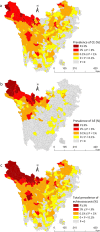Prevalence and spatial distribution patterns of human echinococcosis at the township level in Sichuan Province, China
- PMID: 34090538
- PMCID: PMC8180058
- DOI: 10.1186/s40249-021-00862-z
Prevalence and spatial distribution patterns of human echinococcosis at the township level in Sichuan Province, China
Abstract
Background: Echinococcosis is a global zoonotic parasitic disease caused by Echinococcus larvae. This disease is highly endemic in Sichuan Province, China. This study investigates the prevalence and spatial distribution characteristics of human echinococcosis at the township level in Sichuan Province, geared towards providing a future reference for the development of precise prevention and control strategies.
Methods: Human prevalence of echinococcosis was evaluated using the B-ultrasonography diagnostic method in Sichuan Province between 2016 and 2019. All data were collected, collated, and analyzed. A spatial distribution map was drawn to intuitively analyze the spatial distribution features. Eventually, the spatial autocorrelation was specified and local indicators of spatial association (LISA) clustering map was drawn to investigate the spatial aggregation of echinococcosis at the township level in Sichuan Province.
Results: The prevalence of echinococcosis in humans of Sichuan Province was 0.462%, among which the occurrence of cystic echinococcosis (CE) was 0.221%, while that of alveolar echinococcosis (AE) was 0.244%. Based on the results of the spatial distribution map, a predominance of echinococcosis in humans decreased gradually from west to east and from north to south. The Global Moran's I index was 0.77 (Z = 32.07, P < 0.05), indicating that the prevalence of echinococcosis in humans was spatially clustered, exhibiting a significant spatial positive correlation. Further, the findings of local spatial autocorrelation analysis revealed that the "high-high" concentration areas were primarily located in some townships in the northwest of Sichuan Province. However, the "low-low" concentration areas were predominantly located in some townships in the southeast of Sichuan Province.
Conclusions: Our findings demonstrated that the prevalence of echinococcosis in humans of Sichuan Province follows a downward trend, suggesting that the current prevention and control work has achieved substantial outcomes. Nevertheless, the prevalence in humans at the township level is widely distributed and differs significantly, with a clear clustering in space. Therefore, precise prevention and control strategies should be formulated for clusters, specifically strengthening the "high-high" clusters at the township level.
Keywords: China; Echinococcosis; Prevalence; Sichuan; Spatial autocorrelation.
Conflict of interest statement
All of the authors declared that they had no competing interests.
Figures




Similar articles
-
Spatiotemporal distribution of newly diagnosed echinococcosis patients in Sichuan Province, China, 2013-2024.PLoS Negl Trop Dis. 2025 Aug 4;19(8):e0013358. doi: 10.1371/journal.pntd.0013358. eCollection 2025 Aug. PLoS Negl Trop Dis. 2025. PMID: 40758727 Free PMC article.
-
Geographic distribution of echinococcosis in Tibetan region of Sichuan Province, China.Infect Dis Poverty. 2018 Nov 2;7(1):104. doi: 10.1186/s40249-018-0486-4. Infect Dis Poverty. 2018. PMID: 30384860 Free PMC article.
-
Geographic distribution and prevalence of human echinococcosis at the township level in the Tibet Autonomous Region.Infect Dis Poverty. 2022 Jan 21;11(1):10. doi: 10.1186/s40249-022-00933-9. Infect Dis Poverty. 2022. PMID: 35063031 Free PMC article.
-
Echinococcosis transmission on the Tibetan Plateau.Adv Parasitol. 2019;104:165-246. doi: 10.1016/bs.apar.2019.03.001. Epub 2019 Apr 22. Adv Parasitol. 2019. PMID: 31030769 Review.
-
[Epidemiological characteristics of canine Echinococcus infection in Qinghai-Tibet Plateau of China].Zhongguo Xue Xi Chong Bing Fang Zhi Za Zhi. 2017 Apr 7;29(2):129-138. doi: 10.16250/j.32.1374.2017004. Zhongguo Xue Xi Chong Bing Fang Zhi Za Zhi. 2017. PMID: 29469312 Review. Chinese.
Cited by
-
[Relationship Between the Level of Anatomical Risk of Hepatic Alveolar Echinococcosis and Complications after Radical Resection].Sichuan Da Xue Xue Bao Yi Xue Ban. 2022 Sep;53(5):770-776. doi: 10.12182/20220960108. Sichuan Da Xue Xue Bao Yi Xue Ban. 2022. PMID: 36224677 Free PMC article. Chinese.
-
A Knowledge Survey on Health Education of Echinococcosis Among Students - Ganzi Tibetan Autonomous Prefecture, Sichuan Province, China, 2020.China CDC Wkly. 2022 Feb 25;4(8):137-142. doi: 10.46234/ccdcw2022.005. China CDC Wkly. 2022. PMID: 35356591 Free PMC article.
-
Prevalence and spatial distribution characteristics of human echinococcosis: A county-level modeling study in southern Xinjiang, China.Heliyon. 2024 Mar 28;10(7):e28812. doi: 10.1016/j.heliyon.2024.e28812. eCollection 2024 Apr 15. Heliyon. 2024. PMID: 38596126 Free PMC article.
-
Spatiotemporal distribution of newly diagnosed echinococcosis patients in Sichuan Province, China, 2013-2024.PLoS Negl Trop Dis. 2025 Aug 4;19(8):e0013358. doi: 10.1371/journal.pntd.0013358. eCollection 2025 Aug. PLoS Negl Trop Dis. 2025. PMID: 40758727 Free PMC article.
-
Epidemiology and Clinical Characteristics of Cerebral Alveolar Echinococcosis in the Tibetan Region of Sichuan, China.Am J Trop Med Hyg. 2024 Mar 5;110(4):706-712. doi: 10.4269/ajtmh.23-0619. Print 2024 Apr 3. Am J Trop Med Hyg. 2024. PMID: 38442426 Free PMC article.
References
-
- Eckert J, Gemmell MA, Meslin FX, Pawlowski ZS. WHO/OIE manual on echinococcosis in humans and animals: a public health problem of global concern. Vet Parasitol. 2001;31(14):1717–1718.
-
- Lei ZL, Wang LY. Control situation and primary task of key parasitic diseases in China. Zhongguo Ji Sheng Chong Xue Yu Ji Sheng Chong Bing Za Zhi. 2012;30(1):1–5. - PubMed
-
- Xiao N, Qiu JM, NaKao M, Li TY, Chen XW, et al. Biological features of a new Echinococcus species (Echinococcus shiquicus) in the east of Qinghai-Tibet Plateau. Zhongguo Ji Sheng Chong Xue Yu Ji Sheng Chong Bing Za Zhi. 2008;26(4):307–312. - PubMed
MeSH terms
Grants and funding
LinkOut - more resources
Full Text Sources

